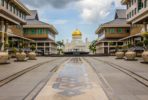While I had hoped for my first article of the New Year to be filled with positivity and written with a light heart, I made the mistake of turning on the television on New Year’s Eve. The scene televised from Dataran Merdeka made my heart skip a beat.
There, instead of our usual cultural dance shows and performances by local artistes while we await the countdown to the New Year, were many people dressed in Arab gear chanting and swaying their bodies to recitations exulting the Prophet Muhammad and Allah.
I only realised that the televised scene was in Kuala Lumpur when I saw the iconic Sultan Abdul Samad building in the background.
I waited for a few minutes in disbelief, urging the television set to change the scene to one I was more familiar with. I was waiting for the usual jingle of “Malaysia, truly Asia”, for that crowd of dancers in exuberant costumes representing the stereotypical image of a culturally diverse Malaysia that I know to be over-exaggerated, but I have to admit, I now miss.
That image never came.
I was secretly glad that I spent New Year’s Eve at a running event in Malacca. As I finished the run before midnight and away from the revelry of the celebrants, I could see Malaysian families coming together at the field either for the run or to usher in the New Year amid fireworks.
My friends and I even shared a table with strangers at a famous chicken rice ball restaurant — a crowd that consisted of foreigners, locals and out-of-town Malaysians alike — enjoying what we Malaysians are most famous for: the food.
That is the Malaysia I know, people from different ethnic groups just sitting together at a street-side stall or dingy restaurant, placing our orders in simple Bahasa or Hokkien or Tamil, even. Nearly everyone would be eating similar fare.
Perhaps this is a grittier, more realist image of the country I love than the usual annual fanfare we put on stage.
What I experienced on New Year’s Eve was not what was shown on television that night.
WHAT IT MEANS TO BE MALAYSIAN
I am sure that every Malaysian has the same wishes as those at Dataran Merdeka — a fresh new start to the year, leaving behind all the heartaches of the past year, hopes for a better Malaysia that we will continue to build together.
What really bothered me about the televised image was the assumption that Malaysia only belongs to those of a particular religion and, it goes without saying, of a particular race.
Yes, it was the image of a peace-loving Islam, led by none other than Indonesia-born preacher Habib Syech Abdul Qadir as-Seggaf, who professes to be a direct descendant of Prophet Muhammad himself.
Under the country’s secular Federal Constitution, every Malaysian is allowed freedom of religion and freedom of expression — thus, the crowd in Dataran Merdeka has every right to chant their love for the Prophet and raise their voices to the high heavens in hope of a better, less arduous year.
Believe me, I hope and pray for better, too. Yet, I saw an Arab country in that televised scene, not Malaysia.
I did not see any of the VVIPs in baju Melayu, sampin (accompanying sarong-like cloth worn by men around the waist) and songkok — most, if not all of them, were in flowy, white jubahs (a long garb commonly worn by Muslims) complete with kopiah (traditional cap), sitting on cushions that reminded me of nomads living in the desert, rather than the usual sofas reserved for VVIPs at government-organised events.
I did not see women during the brief televised set, though from news reports I was informed that the crowd consisted of families. It would have been wonderful if the women were in kebayas and batik sarongs, with their hair in elegant sangguls (bun hairstyle), but I do not think this was the case.
I understand that the clothes worn there are meant for prayers, as the VVIPs led the crowd for Isya’ prayers beforehand — however, have we not seen our leaders leading prayers in baju Melayu every Raya? Are we now so immersed in Arabic culture that we have completely forgotten our own?
We surely forgot that Malaysia consists of non-Muslims, too. Would it not have been more meaningful to hold an interfaith session, where every Malaysian can come together, pray for a better nation and a better year, and at the same time learn the nuances of the different faiths, interact with each other side by side and essentially be Malaysians?
Surely that would have been the best way to organise such an event if it is the spiritual aspect we are aiming for.
It is sad to think that I am reduced to feeling Malaysian only when I go for overseas conferences, at running events and at roadside stalls.
In this new year, I urge that we all reassess our own Malaysian identities before adopting another.
ABOUT THE AUTHOR:
Lyana Khairuddin, a columnist at The Malaysian Insider, does research on the Human Immunodeficiency Virus (HIV) and Human papillomavirus (HPV) viruses and teaches at a Malaysian public university.o
Source: www.todayonline.com







